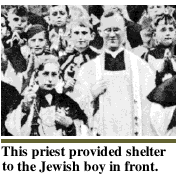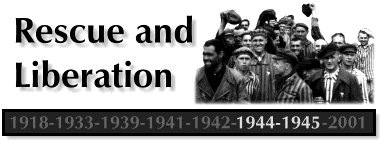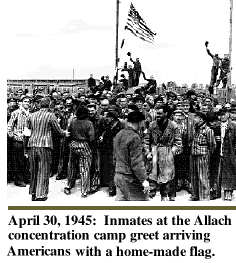
|
 Those who attempted to rescue Jews and others from the Nazi death sentence did so at great risk to their own safety. Anyone found harboring a Jew, for example, was shot or publicly hanged as a warning to others. Sharing scarce resources with those in hiding was an additional sacrifice on the part of the rescuer. Despite the risks, thousands followed the dictates of conscience. In Denmark, 7,220 of its 8,000 Jews were saved by a citizenry who hid them, then ferried them to the
safety of neutral Sweden.
Those who attempted to rescue Jews and others from the Nazi death sentence did so at great risk to their own safety. Anyone found harboring a Jew, for example, was shot or publicly hanged as a warning to others. Sharing scarce resources with those in hiding was an additional sacrifice on the part of the rescuer. Despite the risks, thousands followed the dictates of conscience. In Denmark, 7,220 of its 8,000 Jews were saved by a citizenry who hid them, then ferried them to the
safety of neutral Sweden.
 Map showing the rescue of Danish Jews in the fall of 1943. Map showing the rescue of Danish Jews in the fall of 1943.
Better known rescuers include Raoul Wallenberg, the Swedish diplomat who led the effort that saved 100,000 Hungarian Jews in
1944. Another rescuer, Oscar Schindler, saved over 1,000 Polish Jews from their deaths. Huguenot Pastor André Trocme led the rescue effort in Le Chambon-sur-Lignon, France, which hid and protected 5,000 Jews. Over 13,000 men and women who risked their lives to rescue Jews have been honored as "Righteous Gentiles" at the Yad Vashem Holocaust Memorial in Jerusalem. Thousands more remain unrecognized.
 Photo of a group of children who were sheltered in Le Chambon-sur-Lignon, a town in southern France. Photo of a group of children who were sheltered in Le Chambon-sur-Lignon, a town in southern France.
 Visit the Rescuers page of the People section for more information about rescuers and Web links to many individual accounts. Visit the Rescuers page of the People section for more information about rescuers and Web links to many individual accounts.
 The Holocaust Heroes Website is an ongoing effort to document the rescue of Jews by church groups. The Holocaust Heroes Website is an ongoing effort to document the rescue of Jews by church groups.
 Varian Fry was an American who went to France on behalf of the Emergency Rescue Committee with the mission of rescuing artists, writers, academics, and others at risk. Varian Fry was an American who went to France on behalf of the Emergency Rescue Committee with the mission of rescuing artists, writers, academics, and others at risk.
 Map showing rescue and escape from German-occupied Europe in 1942. Map showing rescue and escape from German-occupied Europe in 1942.
 Visit the Rescue Literature page of the Arts section for an annotated bibliography of recommended works. Visit the Rescue Literature page of the Arts section for an annotated bibliography of recommended works.
|


 Allied troops who stumbled upon the concentration camps were shocked at what they found. Large ditches filled with bodies, rooms of baby shoes, and gas chambers with fingernail marks on the walls all testified to Nazi brutality. General Eisenhower insisted on photographing and documenting the horror so that future generations would not ignore history and repeat its mistakes. He also forced villagers neighboring the death and concentration camps to view what had occurred in their own backyards.
Allied troops who stumbled upon the concentration camps were shocked at what they found. Large ditches filled with bodies, rooms of baby shoes, and gas chambers with fingernail marks on the walls all testified to Nazi brutality. General Eisenhower insisted on photographing and documenting the horror so that future generations would not ignore history and repeat its mistakes. He also forced villagers neighboring the death and concentration camps to view what had occurred in their own backyards.